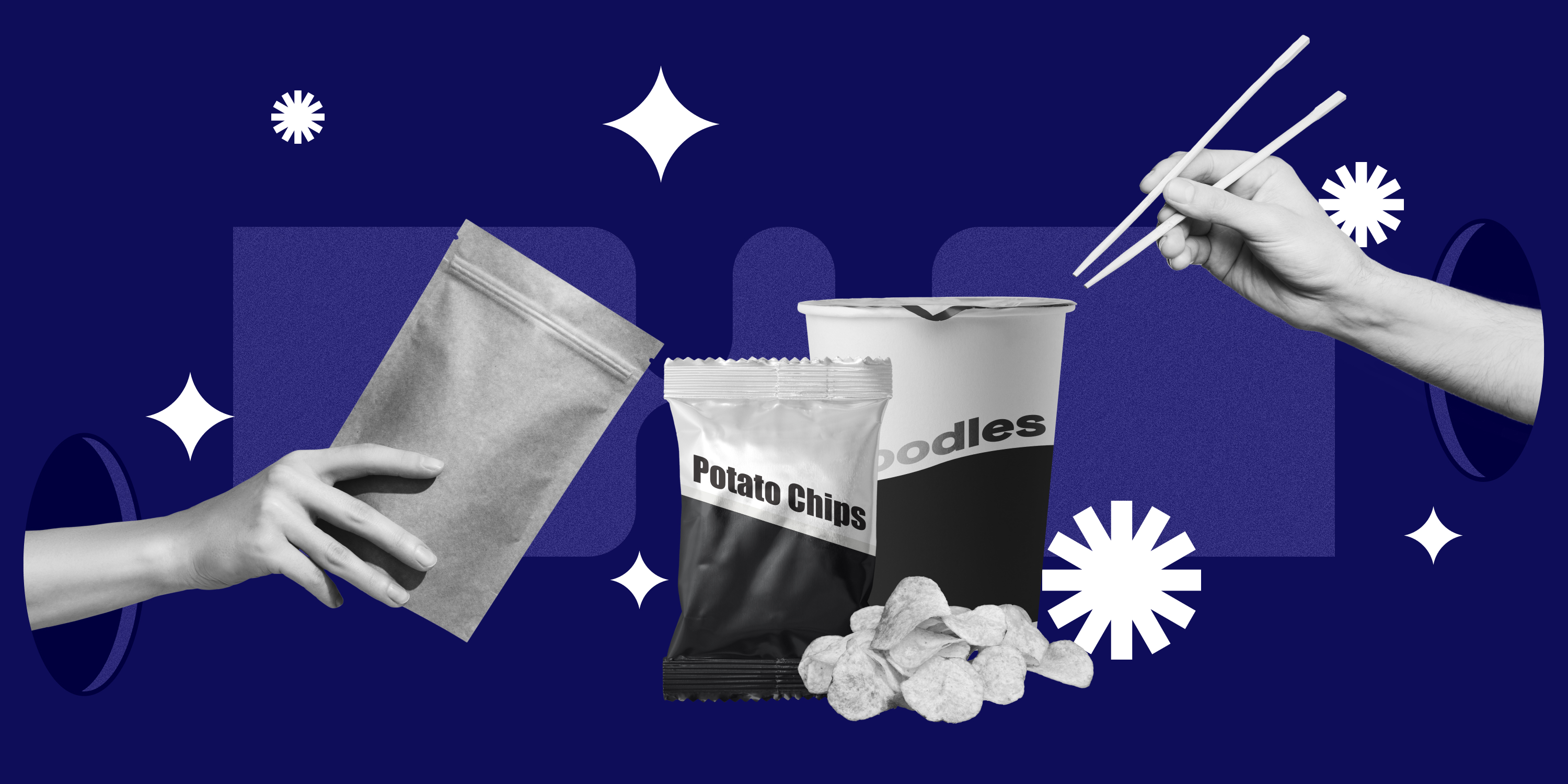
THE 2023 CPG CUSTOMER JOURNEY
Food & Beverage
CONTENTS
Food and Beverage Searches are Most Likely to Start on Walmart
Among the 80% of shoppers who search for prepackaged food and beverage products online, Walmart is the most popular starting point, followed in a distant second by Amazon. While Amazon is a dominant force in many categories, its share of the online grocery market in particular lags its popularity for other product types.
Kroger, the largest national grocery-specific chain in the United States, accounted for the third-highest share of respondents as the website/app they’re most likely to start a food and beverage search on, with Target a close fourth. Less than 4% of respondents selected a traditional search engine like Google or Bing to start food and beverage product searches, and respondents were far more likely to head directly to websites that sold these products than search for relevant results through a search engine.

GENERATIONAL INSIGHTS
Walmart’s popularity was consistent across generations with 45% of both Gen Z and baby boomers picking it as the website or app where they are most likely to start a food search, among those that do search for food and beverage products online. Importantly though, boomers were far less likely to search for food products online in the first place, with 29% saying they don’t, compared to just 3% for Gen Z.

Social Media Plays a Huge Role in Surfacing Food and Beverage Products
Looking across media channels, television scored the highest share of respondents in terms of where they had seen or heard about a food or beverage product that they later went on to purchase in the last year at 36%. This was followed by social media platforms, through which 30% of all respondents recalled first discovering a food/beverage product.
GENERATIONAL INSIGHTS
Gen Z exhibited above average product discovery recall for nine of the 11 media sources assessed for this report, with the two exceptions being print newspapers/magazines and in-store displays. 51% of Gen Z respondents said that they had bought a food or beverage product in the last year after seeing it on social media, compared to just 27% for other age groups.
Facebook Still Dominates Social Product Discovery, but TikTok is Making Inroads
Facebook saw the highest share of respondents say that it was the social media platform where they most often discover new food and beverage products, followed by TikTok and then Instagram. Fewer than half of respondents said they hadn’t discovered a new food or beverage product they later went on to purchase through social media.

GENERATIONAL INSIGHTS
Not surprisingly, social media is a bigger influence on younger generations with 84% of Gen Z members saying they discover food and beverage products on social platforms, compared to just 44% for baby boomers. TikTok was the most popular discovery platform for Gen Z with 29% of respondents saying they discover new food products there, compared to just 10% for Facebook and 23% for Instagram.
How Influential are Influencers?
Influencers play a meaningful part in the impact of social media, as 60% of respondents said they had purchased a food or beverage product based on the recommendation of an online influencer in the last year. With just 25% of respondents saying they follow food and beverage brands on social media, influencers can be more likely to reach most social users than brand accounts. 19% of respondents said they purchased influencer-promoted food and beverage products frequently or very frequently, and finding the right influencers to partner with to reach these shoppers can meaningfully move the needle for brands.
GENERATIONAL INSIGHTS
With 18% of Gen Z members saying that the best description of their approach to buying food and beverage products is that they “like to look for new products or brands to try,” they are particularly open to the impact of online influencers. Only 14% of Gen Z respondents said they had not bought a food or beverage product based on the recommendation of an influencer in the past year, while 34% said they have done this either frequently or very frequently. For baby boomers, 61% say they have not been swayed by influencers in the past year and just 8% said they had frequently or very frequently bought a food or beverage product based on an influencer’s recommendation.
Streaming Has Plenty of Runway to Grow Influence as New Ads Come Online
With 75% of respondents saying they watched television daily and 66% saying the same for social media, these two channels are clearly important to getting in front of potential new customers. 44% of respondents consume streaming video daily, and while just 10% recalled discovering a food or beverage product they later went on to purchase through the channel, that share is only likely to grow as cord-cutting continues and historically subscription-only streaming platforms like Netflix roll out ad-supported tiers.
When it comes to what kind of ads consumers prefer to see online, only 39% of food and beverage shoppers prefer ads created to appeal to the most people, as most respondents want offers that are catered to them or groups who share similarities with them. 23% prefer offers personalized to them based on past actions they’ve taken. 22% preferred offers crafted to appeal to people who share their general interests, and 17% want offers to be focused on what appeals to others who share similar demographics.
Physical Grocery Stores Still Dominate Food and Beverage Purchases
In terms of where shoppers purchase food and beverage products, 75% of respondents say they bought at grocery stores in the last month, while 57% shopped at big-box stores like Walmart and Target. The third most popular place to convert was online at a major retailer like Amazon or Walmart, with 32% of respondents.
Among online destinations, Walmart accounted for the largest share of websites/apps when it comes to where consumers are most likely to make food and beverage purchases. Its 37% response rate was more than double that of the next closest competitor, Amazon, and more than five times that of the largest grocery store, Kroger. Only 20% of respondents don’t make any food or beverage purchases online.

GENERATIONAL INSIGHTS
While 12% of all respondents said that they have bought food or beverage products from a delivery service like Instacart or GoPuff in the past month, that rate jumps to 19% for members of Gen Z. Gen Z was also nearly three times as likely to buy food products online from a DTC brand as other generations, with 13% of Gen Z doing so in the past month.
How Do Food and Beverage Shoppers Really Feel About Retail Media Ads?

Several components of product detail pages garnered significant votes as helpful for consumers trying to decide whether or not to make a food or beverage purchase online. The most selected choice was written reviews, followed closely by ingredient/nutritional information and photos.
When asked about their perception of sponsored ad listings on sites like Amazon and Walmart, 47% of respondents either didn’t have a strong opinion or had never noticed the listings. Combined with the 23% of respondents who find these listings helpful for revealing products that they might otherwise not know about and the 11% who say these listings are typically the products that are most relevant to them, the vast majority of food and beverage shoppers have perceptions of retail media listings ranging from neutral to positive.
Inflation is Weighing on Food and Beverage Customers
43% of food and beverage shoppers said they bought cheaper brands over the last year as a result of product price inflation, with 38% shopping around more and 36% searching more for promos and coupon codes. 34% of all respondents describe their approach to food and beverage purchases as searching for the best price among comparable products, though this is influenced by family size – just 31% of respondents with no children say this, compared to 37% of those who have three or more children.
GENERATIONAL INSIGHTS
Adult Gen Z members were most likely to say that inflation has impacted their food and beverage purchases, with 94% saying they had taken specific measures to deal with higher food prices. Gen Z was more likely than other age groups to say that they were buying cheaper food and beverage brands with 50% doing so, compared to just 36% among baby boomers. Boomers were generally more likely than other generations to say “I tend to buy the same products whenever I need them.”
While inflation is impacting some purchase decisions, many food and beverage shoppers are highly loyal when it comes to which brands they purchase, and 25% said they buy the same exact products whenever they need them. Nearly 80% of respondents belonged to at least one loyalty program related to their food and beverage purchases, and 38% said that instant savings on certain products is most valuable to them when it comes to loyalty program perks. Coupons/rewards that can be used for future purchases were a close second at 34%.